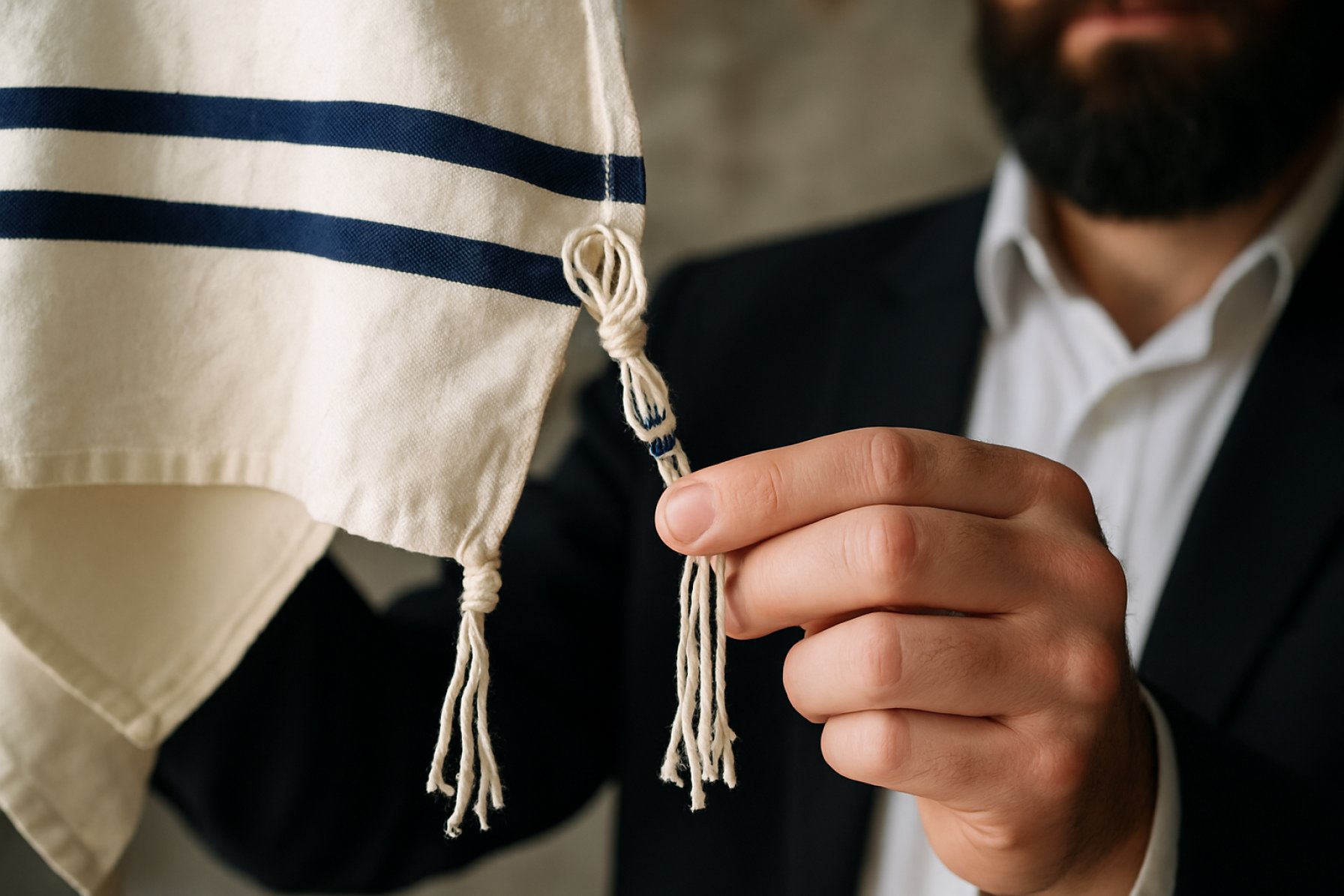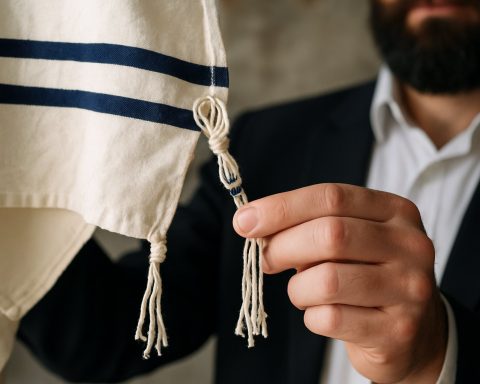Tzitzit Unraveled: Discover the Spiritual, Historical, and Cultural Significance of Jewish Ritual Fringes. Explore How This Ancient Commandment Continues to Inspire and Connect Generations.
- Introduction: What Are Tzitzit?
- Biblical Origins and Commandments
- Symbolism and Spiritual Meaning
- How Tzitzit Are Made: Materials and Methods
- The Role of Tekhelet: The Blue Thread Debate
- Wearing Tzitzit: Customs and Practices Across Communities
- Tzitzit in Daily Life and Prayer
- Women and Tzitzit: Perspectives and Practices
- Modern Interpretations and Contemporary Relevance
- Conclusion: The Enduring Legacy of Tzitzit
- Sources & References
Introduction: What Are Tzitzit?
Tzitzit are ritual fringes or tassels attached to the four corners of a garment, as commanded in the Torah, specifically in Numbers 15:37-41 and Deuteronomy 22:12. Traditionally, these fringes are affixed to a special four-cornered garment called a tallit (prayer shawl) or a tallit katan (small tallit), which is worn daily by many observant Jewish men and, in some communities, by women as well. The primary purpose of tzitzit is to serve as a physical reminder of the commandments and the covenant between the Jewish people and God, encouraging mindfulness and spiritual awareness throughout daily life.
The mitzvah (commandment) of tzitzit is unique in that it is both a symbolic and a practical observance, integrating religious identity into everyday attire. The fringes themselves are carefully constructed, with specific numbers of knots and windings, and, according to tradition, one of the threads was originally dyed with a blue color known as tekhelet. Over centuries, the practice of wearing tzitzit has evolved, reflecting diverse customs and interpretations across Jewish communities. Today, tzitzit remain a visible and meaningful expression of Jewish faith, identity, and continuity, as well as a subject of ongoing religious discussion and legal analysis within halakhic literature (Rabbi Sacks).
Biblical Origins and Commandments
The biblical origins of tzitzit are found primarily in two passages of the Torah. The first, in Numbers 15:37-41 – Sefaria, commands the Israelites to attach fringes to the corners of their garments, with a thread of blue (tekhelet) included in each fringe. The text emphasizes that the tzitzit serve as a visual reminder to observe all of God’s commandments and to maintain spiritual integrity. The second reference appears in Deuteronomy 22:12 – Sefaria, which reiterates the obligation to make fringes on the four corners of one’s garment.
These commandments are understood by rabbinic tradition as positive mitzvot (commandments to perform an action), and their observance is considered a daily obligation for Jewish men, particularly when wearing a four-cornered garment. The inclusion of the blue thread, tekhelet, is historically significant; while its use was lost for centuries due to the unknown identity of the dye source, modern research and tradition have led to its partial restoration in some communities (Ptil Tekhelet Foundation).
The biblical texts frame tzitzit as a physical and spiritual safeguard, linking the act of wearing them to the broader covenantal relationship between the Jewish people and God. The commandment is unique in its explicit rationale: to “remember and perform all My commandments and be holy to your God,” highlighting the role of tzitzit as both a symbol and a tool for religious mindfulness.
Symbolism and Spiritual Meaning
The tzitzit, or ritual fringes attached to the corners of a tallit (prayer shawl) or tallit katan (a smaller garment), are imbued with deep symbolism and spiritual meaning within Judaism. According to the Torah, the commandment to wear tzitzit serves as a tangible reminder of the mitzvot (commandments) and the covenant between God and the Jewish people (Sefaria). The fringes are intended to prompt mindfulness and spiritual awareness, as explicitly stated in the biblical passage: “You shall look upon it and remember all the commandments of the Lord and do them” (Numbers 15:39).
The blue thread, known as tekhelet, historically dyed from a specific sea creature, further enhances the tzitzit’s symbolism. Tekhelet is associated with divine revelation and the vastness of the heavens, serving as a visual cue to aspire toward spiritual elevation and ethical conduct (Rabbi Sacks). The knots and windings of the tzitzit are also interpreted by rabbinic tradition as numerically corresponding to the 613 commandments, reinforcing the garment’s role as a daily spiritual guide (Chabad.org).
Beyond their ritual function, tzitzit symbolize Jewish identity, humility, and the constant striving for holiness. By wearing tzitzit, individuals are reminded of their responsibilities and the presence of the divine in everyday life, transforming a simple garment into a profound spiritual tool.
How Tzitzit Are Made: Materials and Methods
The process of making tzitzit, the ritual fringes attached to the corners of a tallit (prayer shawl) or tallit katan (small garment), is governed by detailed halachic (Jewish legal) requirements. Traditionally, tzitzit are made from threads spun from natural fibers, most commonly wool or cotton, as these materials are considered valid for fulfilling the biblical commandment. The Torah specifies that the garment and its fringes should be of the same material, with wool and linen being the primary materials mentioned in classical sources. However, rabbinic authorities have permitted cotton and, in some cases, other natural fibers for the fringes, provided the garment itself is made from the same material Rabbinical Assembly.
The tzitzit themselves are made by taking four long threads, folding them in half, and threading them through a hole near the corner of the garment, resulting in eight dangling ends. The threads are then knotted and wound in a specific pattern: a double knot, followed by a series of windings, repeated four times, with each section separated by double knots. The number of windings and knots is traditionally 7-8-11-13, corresponding to symbolic numerology in Jewish tradition. Some tzitzit include a thread dyed with tekhelet, a blue dye derived from a sea creature, as described in the Torah, though this practice was lost for centuries and has only recently been revived by some communities Orthodox Union.
The entire process, from spinning the threads to tying the knots, is often performed with the intention (kavanah) of fulfilling the mitzvah, adding spiritual significance to the physical act Chabad-Lubavitch.
The Role of Tekhelet: The Blue Thread Debate
A central aspect of the tzitzit commandment is the inclusion of a thread of tekhelet, a blue dye, as described in the Torah: “And it shall be unto you for a fringe, that ye may look upon it, and remember all the commandments of the Lord” (Sefaria). Historically, tekhelet was derived from a specific sea creature, traditionally identified as the chilazon. Over centuries, the precise identity of the chilazon and the method of producing authentic tekhelet were lost, leading most Jewish communities to wear only white fringes.
The modern era has seen a revival of interest in tekhelet, spurred by archaeological and scientific research. Some scholars and rabbis argue that the Murex trunculus sea snail is the original source of the dye, based on findings of ancient dyeing facilities and chemical analysis of blue threads from antiquity (Israel Antiquities Authority). This identification, however, remains controversial. While some halachic authorities endorse the use of Murex-derived tekhelet and encourage its incorporation into tzitzit, others remain skeptical, citing unresolved historical and legal questions (The Chief Rabbinate of Israel).
The debate over tekhelet reflects broader themes in Jewish law: the tension between tradition and innovation, and the role of scientific discovery in religious practice. For many, the reintroduction of tekhelet is a powerful symbol of Jewish continuity and renewal, while for others, the absence of consensus underscores the importance of caution in ritual observance.
Wearing Tzitzit: Customs and Practices Across Communities
The practice of wearing tzitzit, the ritual fringes commanded in the Torah, varies significantly across Jewish communities, reflecting diverse halachic interpretations and cultural traditions. Among Ashkenazi Jews, it is customary for boys to begin wearing a tallit katan (a small, fringed garment) from a young age, often as soon as they start school. In contrast, many Sephardi communities introduce the tallit katan at a later age, sometimes only after a boy becomes bar mitzvah. The style and manner of wearing tzitzit also differ: Ashkenazim typically wear the fringes outside their clothing, while some Sephardim and Yemenite Jews prefer to keep them tucked in, based on modesty considerations and local custom (Rabbi Sacks).
The tallit gadol, the large prayer shawl, is generally worn during morning prayers by adult men in all communities, but the age and circumstances for donning it can vary. In Ashkenazi tradition, men often begin wearing the tallit gadol after marriage, while in Sephardi and Mizrahi communities, it is common for boys to start at bar mitzvah. Additionally, the tying of the tzitzit knots and the inclusion of the blue thread (tekhelet) are subject to different halachic rulings, with some groups reviving the use of tekhelet in recent decades (Chabad-Lubavitch).
These variations highlight the adaptability of the mitzvah of tzitzit, allowing it to serve as a unifying symbol of Jewish identity while accommodating the unique customs of each community.
Tzitzit in Daily Life and Prayer
Tzitzit, the ritual fringes attached to the corners of a four-cornered garment, play a significant role in the daily religious life and prayer practices of observant Jews. Traditionally, men and some boys wear a special undergarment called a tallit katan throughout the day, ensuring that the mitzvah (commandment) of tzitzit is fulfilled continuously. The presence of tzitzit serves as a tangible reminder of the 613 commandments in the Torah, as explicitly stated in Numbers 15:37-41, where the commandment is first introduced.
During morning prayers, a larger prayer shawl known as the tallit gadol is worn, particularly by adult men. The act of donning the tallit and reciting the accompanying blessing is an integral part of the prayer service, symbolizing spiritual readiness and reverence. The tzitzit are often held and kissed at specific points during the recitation of the Shema, reinforcing their role as a physical and spiritual reminder of one’s obligations to God.
While the obligation to wear tzitzit is technically only when wearing a four-cornered garment, the custom of wearing a tallit katan has become widespread to ensure the mitzvah is observed daily. Some communities also have specific customs regarding when children begin wearing tzitzit and the style or material of the garments. The practice of wearing tzitzit thus weaves together daily routine, communal identity, and spiritual mindfulness, as emphasized by The Office of Rabbi Sacks.
Women and Tzitzit: Perspectives and Practices
The question of whether women are obligated or permitted to wear tzitzit has been a subject of discussion across Jewish legal and cultural traditions. Classical Jewish law, as codified by authorities such as Mishneh Torah and Shulchan Arukh, generally exempts women from the commandment, as it is considered a “positive time-bound mitzvah”—a category from which women are traditionally exempt. However, these sources also discuss whether women may voluntarily fulfill the mitzvah. Some authorities, such as Tosafot, permit women to wear tzitzit, while others, like the Shulchan Arukh, express reservations, particularly regarding issues of modesty and the appearance of adopting male ritual garb.
In contemporary practice, perspectives vary widely. In Orthodox communities, it remains rare for women to wear tzitzit, and doing so may be discouraged. In contrast, many non-Orthodox movements, such as The Rabbinical Assembly (Conservative) and Union for Reform Judaism, encourage women’s participation in mitzvot traditionally reserved for men, including wearing tzitzit. For some women, donning tzitzit is a statement of religious equality and spiritual connection, while for others, it remains outside their practice due to tradition or personal conviction. The evolving discourse reflects broader conversations about gender, ritual, and identity within the Jewish world.
Modern Interpretations and Contemporary Relevance
In contemporary Jewish life, the practice of wearing tzitzit—ritual fringes attached to the corners of a four-cornered garment—has evolved to reflect diverse interpretations and modern sensibilities. While traditionally associated with male observance and daily religious practice, recent decades have seen a growing engagement with tzitzit across gender lines and denominational boundaries. Some progressive Jewish communities now encourage women to don tzitzit as an expression of spiritual equality and personal connection to mitzvot, challenging longstanding norms and sparking ongoing halachic debate (Rabbinical Assembly).
The question of techelet—the blue thread once mandated by Torah but lost for centuries—has also gained renewed attention. Recent archaeological and scientific efforts to identify the original source of techelet have led some to reintroduce the blue thread into their tzitzit, while others maintain traditional all-white fringes, reflecting differing views on authenticity and tradition (Ptil Tekhelet Foundation).
Additionally, the symbolism of tzitzit as a reminder of ethical conduct and Jewish identity resonates strongly in the modern era. Many Jews, including those less observant, choose to wear tzitzit as a visible affirmation of heritage and values, adapting the practice to contemporary clothing styles and personal beliefs. This ongoing reinterpretation underscores the enduring relevance of tzitzit as both a ritual object and a living symbol within the evolving tapestry of Jewish life (My Jewish Learning).
Conclusion: The Enduring Legacy of Tzitzit
The enduring legacy of tzitzit lies in their profound ability to connect generations of Jews to their faith, identity, and communal memory. Worn daily by observant Jewish men and increasingly by women in some communities, tzitzit serve as a tangible reminder of the commandments and the covenant between the Jewish people and God. Their presence on garments, as prescribed in the Torah, has fostered a sense of continuity and spiritual mindfulness throughout centuries of Jewish history, even in times of dispersion and adversity. The ritual of donning tzitzit each morning is not merely a fulfillment of a biblical commandment but also an act of reaffirming Jewish values and belonging.
In contemporary times, tzitzit continue to inspire discussion and adaptation, reflecting the dynamic nature of Jewish law and practice. Debates over the inclusion of women, the use of techelet (blue dye), and the integration of tzitzit into modern clothing highlight the ongoing relevance of this ancient mitzvah. Despite these evolving interpretations, the core symbolism of tzitzit—as a visible sign of holiness and commitment—remains unchanged. Their threads weave together tradition, spirituality, and identity, ensuring that tzitzit remain a vital and cherished element of Jewish life. For further reading on the historical and halachic significance of tzitzit, see resources from The Chief Rabbinate of Israel and My Jewish Learning.
Sources & References
- Numbers 15:37-41
- Rabbi Sacks
- Rabbinical Assembly
- Orthodox Union
- Union for Reform Judaism
- My Jewish Learning














